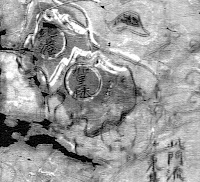July 28th
The morning meeting was short, we were missing a lot of people. Emily and I explained the Archimedes codex. We decided to focus on the outline and getting that done. We spent a lot of time researching the Ambrosiana Library and then the Jubilees Palimpsest. We had to figure out what they actually are and the different texts that make up the palimpsest. We are starting to think about our final presentation, we have half of it pretty much done from the presentation that we had to make for Dave. I feel like we have a good grasp on our topics.








